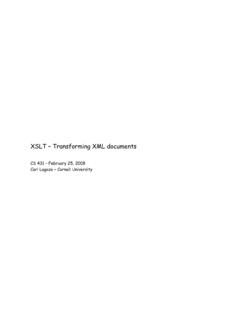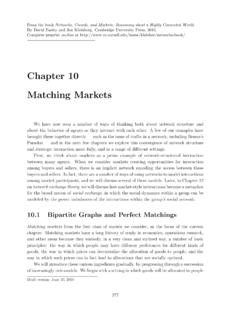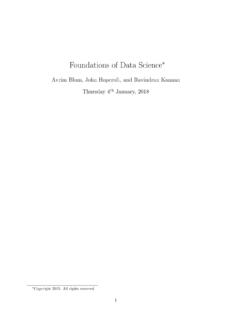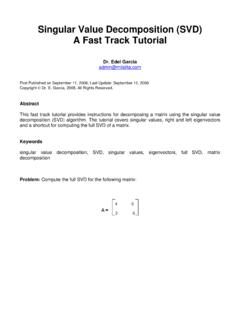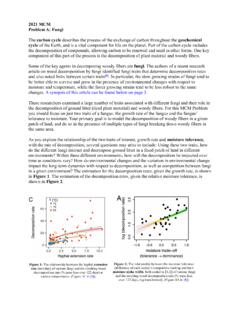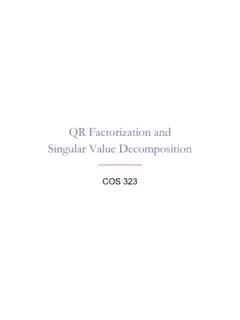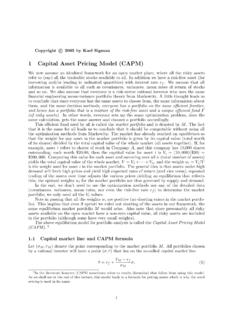Transcription of Householder transformations - Cornell University
1 Bindel, Fall 2012 Matrix Computations (CS 6210). Week 6: Wednesday, Sep 28. Householder transformations The Gram-Schmidt orthogonalization procedure is not generally recommended for numerical use. Suppose we write A = [a1 .. am ] and Q = [q1 .. qm ]. The essential problem is that if rjj kaj k2 , then cancellation can destroy the accuracy of the computed qj ; and in particular, the computed qj may not be particularly orthogonal to the previous qj . Actually, loss of orthogonality can build up even if the diagonal elements of R are not exceptionally small. This is Not Good, and while we have some tricks to mitigate the problem , we need a different approach if we want the problem to go away.
2 Recall that one way of expressing the Gaussian elimination algorithm is in terms of Gauss transformations that serve to introduce zeros into the lower triangle of a matrix. Householder transformations are orthogonal transfor- mations (reflections) that can be used to similar effect. Reflection across the plane orthogonal to a unit normal vector v can be expressed in matrix form as H = I 2vv T . Now suppose we are given a vector x and we want to find a reflection that transforms x into a direction parallel to some unit vector y. The right reflection is through a hyperplane that bisects the angle between x and y (see Figure 1), which we can construct by taking the hyperplane normal to x kxky.
3 That is, letting u = x kxky and v = u/kuk, we have (x + kxky)(xT x + kxkxT y). (I 2vv T )x = x 2. kxk2 + 2xT ykxk + kxk2 kyk2. = x (x kxky). = kxky. If we use y = e1 , we can get a reflection that zeros out all but the first element of the vector x. So with appropriate choices of reflections, we can take a matrix A and zero out all of the subdiagonal elements of the first column. Now think about applying a sequence of Householder transformations to introduce subdiagonal zeros into A, just as we used a sequence of Gauss Bindel, Fall 2012 Matrix Computations (CS 6210). x x kxky kxky Figure 1: Construction of a reflector to transform x into kxky, kyk = 1. transformations to introduce subdiagonal zeros in Gaussian elimination.
4 This leads us to the following algorithm to compute the QR decomposition : function [Q,R] = lec16hqr1(A). % Compute the QR decomposition of an m-by-n matrix A using % Householder transformations . [m,n] = size(A);. Q = eye(m); % Orthogonal transform so far R = A; % Transformed matrix so far for j = 1:n % -- Find H = I-tau*w*w' to put zeros below R(j,j). normx = norm(R(j:end,j));. s = -sign(R(j,j));. u1 = R(j,j) - s*normx;. w = R(j:end,j)/u1;. w(1) = 1;. tau = -s*u1/normx;. % -- R := HR, Q := QH. R(j:end,:) = R(j:end,:)-(tau*w)*(w'*R(j:end,:));. Q(:,j:end) = Q(:,j:end)-(Q(:,j:end)*w)*(tau*w)';. Bindel, Fall 2012 Matrix Computations (CS 6210). end Note that there are two valid choices of u1 at each step; we make the choice that avoids cancellation in the obvious version of the formula.
5 As with LU factorization, we can re-use the storage of A by recognizing that the number of nontrivial parameters in the vector w at each step is the same as the number of zeros produced by that transformation . This gives us the following: function [A,tau] = lec16hqr2(A). % Compute the QR decomposition of an m-by-n matrix A using % Householder transformations , re-using the storage of A. % for the Q and R factors. [m,n] = size(A);. tau = zeros(n,1);. for j = 1:n % -- Find H = I-tau*w*w' to put zeros below A(j,j). normx = norm(A(j:end,j));. s = -sign(A(j,j));. u1 = A(j,j) - s*normx;. w = A(j:end,j)/u1;. w(1) = 1;. A(j+1:end,j) = w(2:end); % Save trailing part of w A(j,j) = s*normx; % Diagonal element of R.
6 Tau(j) = -s*u1/normx;. % -- R := HR. A(j:end,j+1:end) = A(j:end,j+1:end) (tau(j)*w)*(w'*A(j:end,j+1:end));. end If we ever need Q or QT explicitly, we can always form it from the com- pressed representation. We can also multiply by Q and QT implicitly: Bindel, Fall 2012 Matrix Computations (CS 6210). function QX = lec16applyQ(QR,tau,X). [m,n] = size(QR);. QX = X;. for j = n:-1:1. w = [1; QR(j+1:end,j)];. QX(j:end,:) = QX(j:end,:)-(tau(j)*w)*(w'*QX(j:end,:)); . end function QTX = lec16applyQT(QR,tau,X). [m,n] = size(QR);. QTX = X;. for j = 1:n w = [1; QR(j+1:end,j)];. QTX(j:end,:) = QTX(j:end,:)-(tau(j)*w)*(w'*QTX(j:end,:) );. end Givens rotations Householder reflections are one of the standard orthogonal transformations used in numerical linear algebra.
7 The other standard orthogonal transforma- tion is a Givens rotation: . c s G= . s c where c2 + s2 = 1. Note that . c s x cx sy G= =. s c y sx + cy so if we choose y x s= p , c= p x2 + y 2 x2 + y 2. then the Givens rotation introduces a zero in the second column. More generally, we can transform a vector in Rm into a vector parallel to e1 by a sequence of m 1 Givens rotations, where the first rotation moves the Bindel, Fall 2012 Matrix Computations (CS 6210). last element to zero, the second rotation moves the second-to-last element to zero, and so forth. For some applications, introducing zeros one by one is very attractive. In some places, you may see this phrased as a contrast between algorithms based on Householder reflections and those based on Givens rotations, but this is not quite right.
8 Small Householder reflections can be used to introduce one zero at a time, too. Still, in the general usage, Givens rotations seem to be the more popular choice for this sort of local introduction of zeros.

